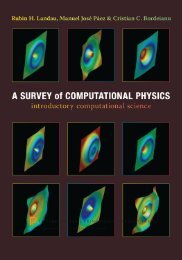Statistical Physics
Statistical Physics
Statistical Physics
- No tags were found...
Create successful ePaper yourself
Turn your PDF publications into a flip-book with our unique Google optimized e-Paper software.
134 9 Second-Order Phase Transitionsthere is no distinction between the gas and liquid phases, but below the criticaltemperature, the densities of these phases are different. The differencein the density develops continuously, like the magnetization, at the criticalpoint, and the internal energy changes continuously. The normal-metalto-superconductorphase transition and the normal-fluid-to-superfluid phasetransition are also examples of second-order phase transitions.Since the transition is continuous, there should be something which allowsus to make a distinction between the phases above and below the transitiontemperature, otherwise we would not be able to detect the existence of thetransition. In many cases the distinction appears in the symmetry of thesystem. In this case the higher-temperature phase has the higher symmetry,and the lower-temperature phase has the lower symmetry. For example, inthe case of the Ising model, the original system has no preference betweenthe up and down directions of each spin. This symmetry is retained in theparamagnetic phase. The up direction and the down direction have equalprobabilities of being realized, and so the average magnetic moment vanishesin the absence of a magnetic field. In the ferromagnetic phase, this symmetryis spontaneously broken. The system has a nonzero magnetic moment pointingeither in the up direction or in the down direction.These two possibilities for the magnetization have the same total energy,and so, from the viewpoint of the canonical distribution, should be realizedwith equal probability. However, in real systems only one of these possibilitiesis realized. This is because the low-temperature phase is created by the cooperationof the spins. Each spin has a favored direction, because the surroundingspins are ordered. Therefore, most of the spins must change direction simultaneouslyfor the system to move from one choice of direction to the other, whichis impossible for a macroscopic system. The creation of a symmetry-brokenstate is called spontaneous symmetry breaking.Although spontaneous symmetry breaking signals the phase transition inmost cases of second-order phase transitions, and it is appropriate to makeuse of this concept to understand the transition qualitatively, for quantitativediscussion of a phase transition it is better to introduce a quantitative variablecalled the “order parameter”. For magnetic systems, the order parameter isthe total magnetic moment, which is generally a vector; for the gas–liquidtransition, it is the difference in the density; for superfluid helium, it is thewave function of the Bose–Einstein condensate; and for a superconductor,it is the wave function of the Cooper pairs. These order parameters vanishcontinuously as the temperature approaches the transition temperature frombelow, and remain zero in the higher-temperature phase.9.2 Landau TheoryHere we consider the general structure of a second-order phase transition. Forsimplicity, we consider the case in which the order parameter Ψ is a real scalar.











![Práctica [PDF] - Universidad de Carabobo, FACYT - computacion](https://img.yumpu.com/48491415/1/190x245/practica-pdf-universidad-de-carabobo-facyt-computacion.jpg?quality=85)




